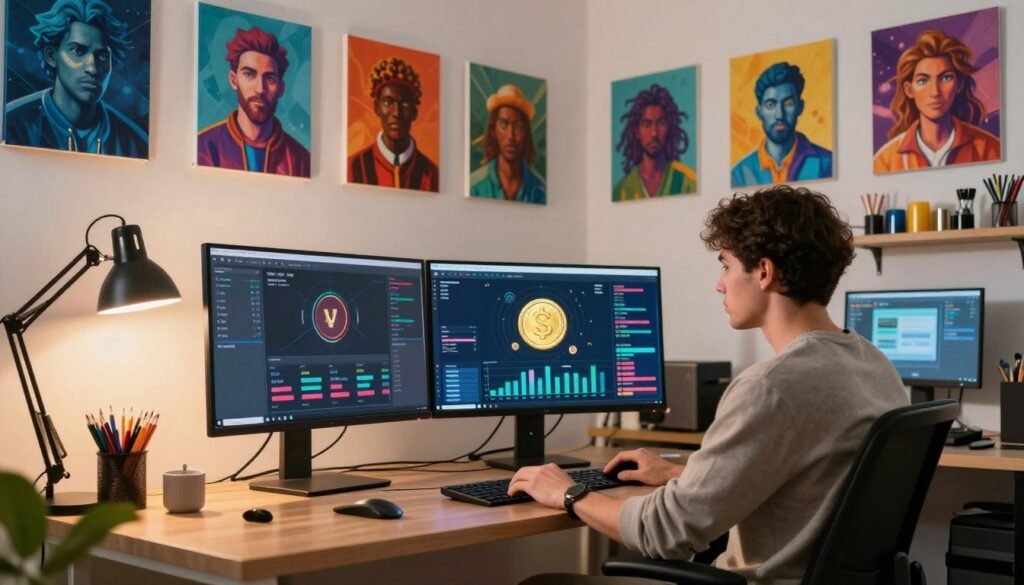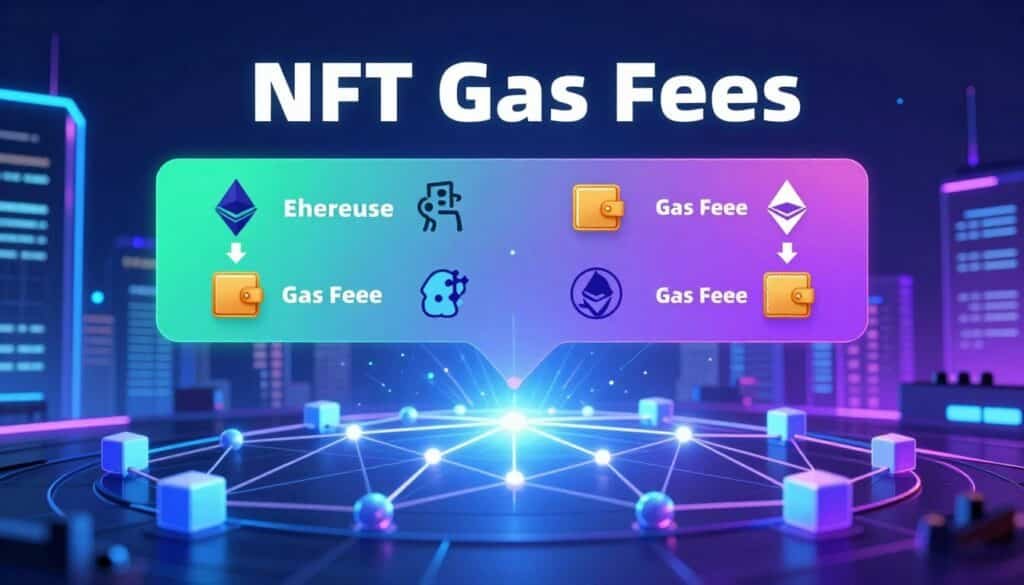Now Reading: Your Complete NFT Minting Guide: Tips and Best Practices
- 01
Your Complete NFT Minting Guide: Tips and Best Practices
Your Complete NFT Minting Guide: Tips and Best Practices
Digital creators are reshaping how art and content gain value in the modern era. By turning their work into blockchain-based assets, they unlock ownership rights and monetization opportunities previously unavailable. This process ensures every piece becomes unique, traceable, and tradable—like a digital fingerprint for authenticity.

Unlike traditional files, these tokens use decentralized technology to prove originality. Artists, musicians, and collectors now leverage this system to build careers and communities. Platforms simplify the creation process, while custom solutions cater to those with technical skills.
Current trends show growing demand for rare digital items. Creators earn through sales, royalties, or even earn rewards through exclusive memberships. This shift empowers individuals to control their work’s distribution and value.
Key Takeaways
- Blockchain technology verifies ownership of digital creations permanently
- Tokens act as certificates of authenticity for art, music, and collectibles
- Multiple platforms offer user-friendly tools for asset creation
- Royalty systems enable ongoing revenue from secondary sales
- Custom smart contracts provide advanced control for creators
Understanding these concepts helps creators protect their work while exploring new income streams. The following sections detail practical steps to navigate this evolving space confidently.
Introduction to NFTs and the Digital Minting Landscape
Blockchain’s immutable records solve a problem artists faced for years: proving ownership of digital files. Unlike physical art, digital pieces lacked built-in authenticity markers. This changed with non-fungible tokens, which assign unique identifiers to creative works like digital barcodes.

Understanding NFTs and Their Unique Value
Each token acts as a certificate of authenticity stored on decentralized ledgers. Even identical-looking files carry distinct codes, making duplication meaningless. This system lets creators verify scarcity for their digital assets, whether art, music, or virtual real estate.
The Evolution of Digital Collectibles on Blockchain
What began as experimental pixel art now spans interactive 3D models and viral social media posts. Brands and musicians use tokens to build communities while earning royalties automatically. The market’s growth reflects a shift: digital ownership now drives value as much as physical possession.
NFT Minting Guide for Beginners
Turning digital files into verifiable blockchain assets opens doors for creators. This transformation relies on two distinct approaches, each with unique advantages for different scenarios.

Breaking Down the Minting Process
Creating blockchain-based collectibles involves converting files into tokens with unique identifiers. Platforms like OpenSea simplify this through intuitive interfaces. You’ll typically follow these steps:
- Prepare high-quality artwork or media files
- Connect a cryptocurrency wallet to your chosen platform
- Add descriptive metadata and ownership details
The step-by-step process varies slightly across marketplaces but always establishes permanent ownership records. Gas fees—transaction costs on blockchain networks—affect pricing during peak times.
Traditional Minting vs Lazy Minting Methods
Traditional methods require immediate payment to register assets on-chain. This guarantees instant verification but can become expensive. Ethereum-based projects often face fluctuating fees during high demand.
Lazy minting delays blockchain registration until purchase. Sellers list items without upfront costs, transferring fees to buyers. This approach works well for testing market interest or managing tight budgets.
New creators often combine both methods. They might use lazy options for initial experiments before switching to traditional minting for high-value pieces. Understanding these differences helps optimize costs while maintaining asset integrity.
Setting Up Your Blockchain Environment
Building your blockchain infrastructure starts with a solid foundation. Begin by creating a dedicated network through platforms like Kaleido. This virtual space will host your digital assets and transactions securely.

Creating Your Kaleido Account and Network
Name your network and choose cloud regions like AWS or Azure based on your audience’s location. These decisions impact transaction speed and data storage compliance. After registration, select Ethereum as your protocol—the standard for most token projects.
Configure nodes using default “small” and “signer” settings. These presets balance performance with cost-efficiency for new creators. If you lack a crypto wallet, set up MetaMask first—it acts as your digital ID for blockchain interactions.
Selecting the Right Deployment Options
Prioritize simplicity when choosing providers. While advanced configurations exist, starter templates work for 90% of projects. Key considerations include:
- Geographic server locations affecting latency
- Automatic backup systems for asset security
- Integration with popular wallet applications
Link your wallet to the network through platform-specific guides. This step bridges your storage system with blockchain operations. Test connections before proceeding—errors here can delay entire projects.
Deploying Smart Contracts for NFT Creation
Smart contracts form the backbone of blockchain-based collectibles, automating ownership rules and transactions. These self-executing agreements ensure every action follows predefined conditions, creating trustless systems for creators and collectors.
Building Your Foundation With ERC721 Standards
Start by accessing your platform’s digital assets section. Choose “tokens” and connect your signing account—the administrative node from your network setup. This account deploys contracts and manages permissions.
Select between two primary contract types:
- KaleidoERC721Mintable: Basic standard for creating unique tokens
- KaleidoERC721MintableBurnable: Adds removal capabilities for dynamic projects
Name your collection carefully—these identifiers become permanent on the blockchain. Symbols should be 3-4 letters for easy recognition across marketplaces. Click “deploy token instance” to finalize.
Your contract becomes the framework for all future actions. While advanced customization exists, standard configurations let creators get started quickly. Double-check settings before deployment—changes require new contracts.
This one-time setup establishes your project’s technical infrastructure. The deployed agreement handles transfers, ownership proofs, and metadata links automatically. Test basic functions before proceeding to actual token creation.
Minting Your NFT and Handling Metadata
When preparing your digital collectibles for blockchain registration, metadata acts as their DNA. This information defines uniqueness, from visual details to ownership history. Proper management ensures your work stands out in crowded marketplaces.
Understanding Token URI and IPFS Storage
The Token URI serves as a roadmap to your asset’s metadata. It links blockchain entries to descriptive files stored off-chain. Most creators use decentralized systems like IPFS to host this data permanently.
IPFS assigns each file a unique content identifier (CID). Unlike traditional URLs, these CIDs can’t be altered or deleted. This protects against broken links that might devalue your tokens over time.
Follow this three-step checklist when setting up metadata:
- Verify image quality matches platform requirements
- Include detailed descriptions and provenance records
- Test URI links across multiple devices
Your smart contract references this data during the minting process. Errors here could disconnect your token from its intended features. Always double-check entries before finalizing blockchain registration.
By mastering these elements, you ensure your digital assets maintain their identity and value. The right approach turns technical steps into long-term advantages for creators and collectors alike.
FAQ
How do gas fees impact blockchain transactions?
Gas fees are payments made to process transactions on networks like Ethereum. These costs fluctuate based on network congestion and complexity. Platforms like Polygon offer lower fees for creators prioritizing affordability.
What’s the difference between ERC721 and ERC1155 contracts?
ERC721 supports unique, single-edition tokens ideal for art. ERC1155 allows semi-fungible tokens, enabling batch creation. Projects like Decentraland use ERC721, while gaming platforms like Enjin leverage ERC1155.
Why is IPFS critical for storing metadata?
IPFS ensures decentralized, tamper-proof storage for files like images or descriptions. Unlike centralized servers, it uses content addressing, making data resilient. Marketplaces like OpenSea rely on IPFS for secure asset linking.
Can I avoid upfront costs with lazy minting?
Yes. Platforms like Rarible let creators defer fees until a sale occurs. This method uses signature-based validation, reducing risk for artists testing demand before committing funds.
How do I choose a blockchain network?
Consider factors like community size, transaction speed, and environmental impact. Ethereum dominates for art, while Flow caters to gaming. For enterprise use, private networks via Kaleido offer customization.
What wallet integrations work best for beginners?
MetaMask remains the most widely supported option, compatible with Ethereum, Polygon, and testnets. For mobile-first users, Trust Wallet provides seamless access to decentralized apps and marketplaces.













